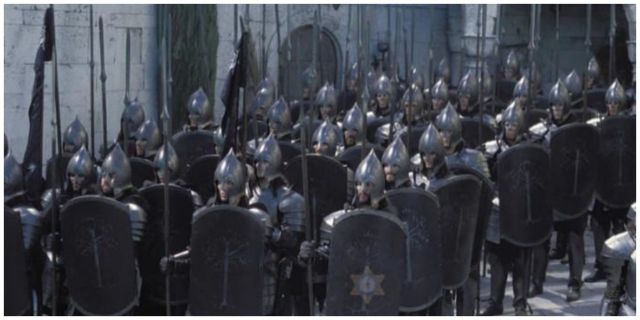Lord of the Rings doesn’t feel like a war story. The franchise’s War for the Ring gradually grows until it fully envelops the narrative, but it still always feels like a more fanciful adventure. The difference is probably mostly in perspective. If the books and films focused primarily on the soldiers instead of the more unique participants in the conflict, it would feel closer to something like Game of Thrones. A slightly earlier chapter in Middle-earth’s history depicts a war called the Kin-strife that feels very different.
Amazon Prime Video’s controversial Rings of Power series kicked open the door for what could be a rush of Lord of the Rings prequels. After Peter Jackson’s landmark cinematic adaptations and his return to the well for The Hobbit, it seemed absurd to think fans wouldn’t see more of Middle-earth. While the first TV prequel covers parts of the Second Age, there are endless stories buried in the franchise’s past that future adaptations could explore.
What started the Kin-Strife?

The Kin-strife is a civil war between forces fighting for control of Gondor. The source of the conflict was rage over the genetic characteristics of the new ruler. Gondor began life as one of the two Kingdoms of the Dúnedain after the Downfall of Númenor. Almost all of its people had the blood of Númenor. As the Third Age began, humans from other cultures gradually moved into Gondor and intermingled with the populace. The first crop of Gondorians also included some of the Men of the Mountains, who willingly followed Elendil, who led the creation of Gondor and its sister kingdom, Arnor. The idea of mixing blood didn’t seem to come up often in the early days, but it gradually became a hot topic as the Northmen of Rhovanion moved into Gondor.
Most saw the Northmen as the second-most noble batch of humans in Middle-earth. Hostilities between Númenóreans and Northmen escalated when Gondor’s new king married a Northmen woman. Valacar, the 20th King of Gondor, married Vidumavi, the King of Rhovanion’s daughter. Their son, Eldacar, stood to inherit the throne when Valacar died. In T.A. 1432, Eldacar ascended, and a sizable portion of Gondorians rioted. The leader of this racist rampage was Castamir, Valacar’s second cousin and Captain of Ships. Many coastal cities supported Castamir’s illegitimate claim, providing him with the power to lay siege to the capital. Castamir and his angry mob burned Osgiliath, ruined the capital’s great hall, and destroyed their seeing stone. The attack forced Eldacar to retreat, entering a decade-long exile in his mother’s land of Rhovanion. While abroad, Eldacar planned his revenge.
Who won the Kin-Strife?

Eldacar spent ten years marshaling his forces and preparing his assault while he lived in Rhovanion. Many of the Northmen of Gondor despised the hateful treatment that befell a king who shared their blood, leading them to join Eldacar’s cause. Meanwhile, Castamir proved to be an awful ruler. He was cruel to his defeated enemy, executing Eldacar’s son in cold blood to prevent the heir from reaching for the throne. He also unfairly favored the coastal cities that supported him, scheming to move the capital to a beachfront location after his brutal sack of Osgiliath. The reign of Castamir left many citizens regretting their response to the Eldacar. Thankfully, the rightful king returned to save them from their awful decisions.
Eldacar emerged suddenly with an army from Rhovanion and marched through Gondor. He gathered countless warriors of Gondor to his banner. Some respected him, while many simply hated Castamir. Eldacar met his second cousin (once removed) at the Battle of the Crossings of Erui. It was a brutal conflict that claimed the lives of countless Gondorians. Eldacar faced Castamir in single combat, where he slayed the usurper singlehandedly. With Castamir dead, Eldacar reestablished his rule and returned to sit upon the throne of Gondor.
What was the aftermath of the Kin-Strife?
The Kin-strife ended with the rightful heir placed on the throne, but its negative effects rang throughout Gondor for generations. Most notably, Castamir’s descendants escaped the war. They forged a new independent lordship and continued to do battle with Gondor as the Corsairs of Umbar. They would terrorize the coasts until Aragorn II Elessar defeated them. Casualties were heavy on both sides, leaving many of Gondor’s finest families dead or dying. This, ironically, led to many more Northmen immigrating to Gondor to occupy the empty land, marry locals, and replenish their dwindling numbers. The Kin-strife also had a psychological impact on every successive king of Gondor. They learned to fear and distrust their relatives, lest they rise up against them like Castamir the Usurper. Many of their kin took that paranoia as a personal affront, leading some to join Castamir’s descendants. This partially led to the end of the Kings of Gondor, as there was no heir to take the throne after Eärnur disappeared. This led to the Stewards of Gondor ruling the nation for generations. The strange reign of Denethor II evolved from Castamir’s anger at the idea of a half-blood king.
The Kin-strife was an outrageously bloody battle that forever changed the history of Gondor. There isn’t much of a lesson in the Kin-strife, especially since any message about the blood of kings goes out the window when Aragorn accepts his birthright. It is, however, worth noting the impact a simple complaint can have. Everyone who hated seeing a king with the wrong background take the throne changed their tune and watched their culture become more accepting of diversity than ever. That’s a win, but its costs probably still outweigh its impact.











Leave a Reply